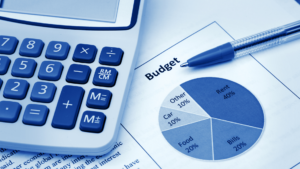Understand what a corporate budget is, its importance, the main types and the steps for creating the document.
The Corporate Budget is a management tool used to project a company's income and expenses over a given period.
Most of the time, this is done on an annual basis, but it can also be done every semester, quarter or month.
Its main objective is to assertively control expenses so that the company spends less and increases profitability.

With this management tool, companies keep their finances organized and can work on goals and projections that contribute to the evolution of the business.
The importance of drawing up a business budget
The business budget helps control spending, financial analysis and, above all, serves as a guide for decision-making.
It is here that managers can find the data they need to get a clear picture of the current situation, which makes it easier to plan the next steps.
Lack of good planning can lead many companies to bankruptcy. AIt is also a way for the company to know how to deal when investment opportunities arise.
The corporate budget is therefore an extremely important tool for businesses of all sizes.
Types of business budget
There are various types of corporate budget. Among the best known on the market are static, variable, continuous and adjusted budgets. We'll talk a little about each of them below.
Static budget
The main characteristic of this type of business budget is that it cannot be changed. In other words, regardless of the company's results, its figures are predetermined and cannot be changed.
This means that expenses are fixed and cannot be exceeded, even if the company has cash available.
Let's say you invest R$ 5,000.00 per month in marketing and advertising services. This amount must not be exceeded within the period for which the budget has been set.
Variable or flexible budget
Unlike the static budget, here there is the possibility of changing the budget pieces according to the volume of production or sales.
Let's suppose that, in a given month, the company doubled its sales. Then it's possible to invest more in marketing actions. For this, margins of change are established, i.e. the extent to which the budget can be made more flexible.
Ongoing budget
The rolling budget also goes by the name of Rolling Forecast. It is a more dynamic type of budget, with monthly reviews.
At the end of each month, the company evaluates this budget and adds another month to the period that was budgeted. This is why it is called continuous.
Adjusted or revised budget
The adjusted budget, also known as the Forecast, has as its main characteristic revisions, which, as with the rolling budget, are made on a monthly basis.
The difference is that a comparison is made between what was spent in previous months to define the necessary adjustments, so if the company is overspending or underspending on certain services, the values are adjusted to achieve a balance.
Main business budget models
The choice of corporate budget model must be made by each company, taking into account its needs.
The most commonly used models are spreadsheets, but there is also the possibility of using software to help with this.
Business budget vs. sales budget
Many people confuse business budgets with sales budget templates. However, they are two completely different documents.
A sales budget is nothing more than a commercial proposal. A business budget, on the other hand, is a detailed plan of the business's general income and expenditure.
READ ALSO: Why is financial planning important for startups?
How to make a rum business budget?
Making a company budget requires intense dedication from the accounting team, so the process requires experience and knowledge and must go through the following stages:
Carrying out the company's financial diagnosis;
- Definition of objectives and targets for the period;
- Sales projections;
- Definition of revenue estimates;
- Survey of costs and expenses;
- Calculation of fixed assets;
- Investment planning;
- Document organization.
The importance of monitoring and reviewing the budget
Creating a business budget is just the beginning. For efficient financial management, it is then necessary to dedicate yourself to continuous monitoring and review of the stipulated goals.
In this way, you can stay true to the company's financial objectives and have greater flexibility to adapt to new possible scenarios, devising new and better strategies.
The most important thing in all of this is to be able to see the business budget as a dynamic instrument, which keeps up with the reality of the business, adapts to the needs, but doesn't let the objectives get lost along the way.
Composition of the Corporate Budget
The main parts of a business budget are:
- Sales planning;
- Sales projections and estimates;
- Budgeting production costs;
- Operating expenses budget;
- Budget for personnel costs;
- Investment projections.
Why hire an accounting firm for budgets?
Firstly, because having an expert team is the best way to generate assertive and dynamic budgets that make it easier to monitor data and information.
One of the great challenges for growing companies is to have a management structure that can meet the new demands that will arise along the way.
Hiring a specialized company is an option that saves resources, since you don't need to hire your own team to do it. What's more, as the company grows, you continue to have the same assertiveness in the process.
Get to know CLM Controller's work now and ensure your company's financial health.

